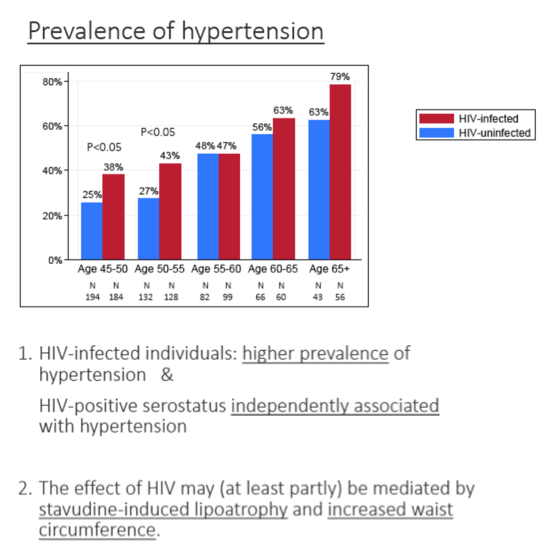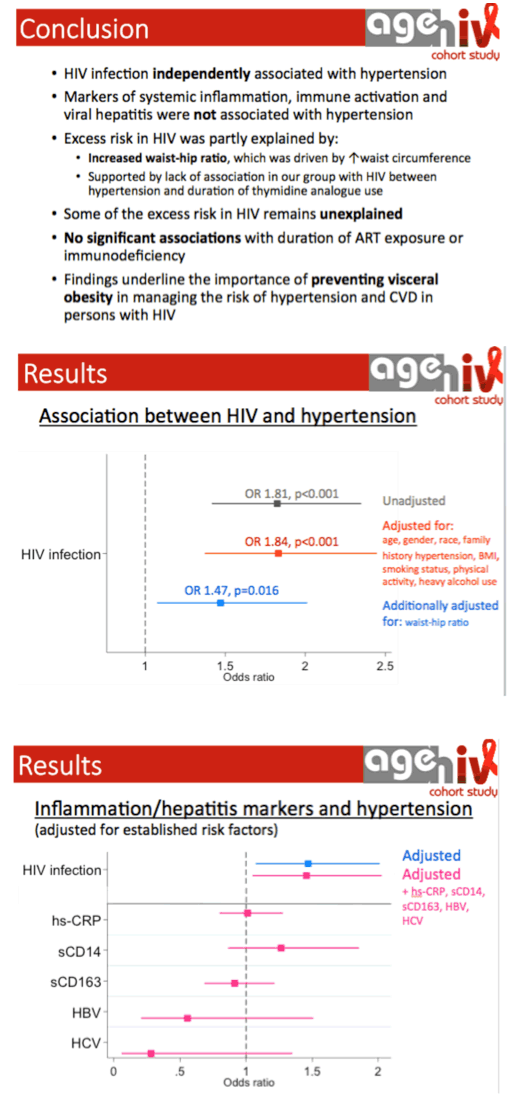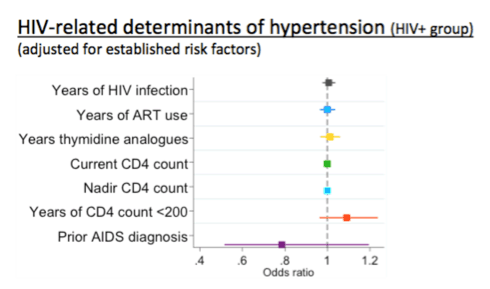| |
Hypertension/79% in >65 HIV+ Causes-Risk Factors
|
| |
| |
Download the PDf here
Hypertension was present among 254 HIV-1-infected (48.2%) and 188 HIV-uninfected individuals (36.4%; ORHIV, 1.63; 95% CI, 1.27-2.09; P < .001).....Both waist circumference and hip circumference were associated with hypertension, but waist-to-hip ratio fitted best to our data.....
body composition, involving both abdominal obesity and stavudine-induced peripheral lipoatrophy, might contribute to the higher prevalence of hypertension in HIV-1-infected patients.....
Our results suggest a role for both abdominal fat accumulation and peripheral lipoatrophy in the pathophysiology of hypertension in the context of HIV." - Higher Prevalence of Hypertension in HIV-1-Infected Patients on Combination Antiretroviral Therapy Is Associated With Changes in Body Composition and Prior Stavudine Exposure......Common risk factors such as age, sex, and body mass index (BMI) [4-9], immune activation and inflammation [10], and antiretroviral drug use and immunodeficiency could contribute to the higher prevalence of hypertension in HIV-infected individuals. AgeHIV Study/Amsterdam - Body Changes / Hypertension / Aging Worsens Affects.
http://natap.org/2016/HIV/060816_01.htm
The influence of nadir CD4 count on hypertension can be explained, in part, by the concept of early aging or immunosenescence.

--------------------------
Hypertension in HIV-Infected Adults
Sasha A. Fahme, Gerald S. Bloomfield, Robert Peck
18 May 2018 Hypertension
pdf attached
Among ART-experienced individuals >50 years, >50% have hypertension.6
In summary, hypertension is common in HIV-infected adults and is likely because of a combination of traditional risk factors, HIV-specific factors, and ART. We have described the current evidence for possible mechanisms of hypertension in HIV-infected adults related to HIV-specific factors and ART. Novel pathophysiologic mechanisms for hypertension in HIV-infected adults may include microbial translocation, chronic inflammation, immune suppression and reconstitution, viral tropism, lipodystrophy, adipokines, and HIV-related renal disease. Large, multinational cohort studies are needed to solidify our knowledge. In addition, interventional studies are needed to discover new interventions for preventing and treating hypertension and hypertension-related cardiovascular disease in HIV-infected adults.
HIV-infected adults with hypertension have a higher risk of cardiovascular events and all-cause mortality than HIV-uninfected adults with hypertension or HIV-infected adults with normal blood pressure.8,13,16-18
prospective cohort study of >80 000 HIV-infected and uninfected American veterans followed during a median 6-year period, for example, found that HIV-infected adults with hypertension had a 2-fold higher risk of incident acute myocardial infarction as compared with HIV-uninfected adults with hypertension.17
Traditional cardiovascular risk factors explain some, but not all, of the increased hypertension risk among HIV-infected adults.14,19,20
Several virologic and treatment-related factors have been implicated in the pathophysiology of hypertension in HIV infection, among them chronic inflammation, immune reconstitution, and lipodystrophy, all of which uniquely influence common downstream pathways such as the sympathetic and renin-angiotensin-aldosterone systems (RAAS).21-25
Hypertension-the leading risk factor for mortality worldwide-is a growing problem in HIV-infected adults.4-11 HIV-infected adults on ART have a higher prevalence of hypertension when compared with HIV-uninfected individuals.4-6,12-15 A recent meta-analysis of data from around the globe demonstrated that 35% of all HIV-infected adults on ART have hypertension, compared with an estimated 30% of HIV-uninfected adults.6 Among ART-experienced individuals >50 years, >50% have hypertension.6
Hypertension in HIV


How Much of Hypertension in HIV-Infected Adults Is Simply Attributable to ART?
Direct ART effect may explain some but not all of the increased risk of hypertension in HIV-infected adults. HIV-infected participants on ART have higher rates of hypertension than ART-naive HIV-infected people.6,9,10,15,24,26-28,30,38,42,106 Although no published studies have quantified the hypertensive risk directly attributed to ART use, many studies done on ART-experienced HIV-infected participants have identified other independent risk factors for hypertension, including nadir CD4 count <50 cells per µL (adjusted OR, 2.48; 95% CI, 1.27-4.83),22 lipodystrophy (OR, 4.80; 95% CI, 2.43-9.85; P<0.0001),4 lipoatrophy (OR, 4.3; 95% CI, 1.5-12.4; P=0.006),21 renal dysfunction,5,30,40,42 and HIV tropism.25 In addition, the higher prevalence of hypertension in ART-experienced adults may be because of the immune reconstitution caused by these drugs rather than direct drug effect on blood pressure.5,44
Findings from observational studies describing HIV-infected adults on different ART regimens should be interpreted with caution for several reasons. First, there is the possibility of selection bias because there may be underlying clinical factors justifying the use of a particular antiretroviral regimen that may consequently influence the development of hypertension. Furthermore, the studies evaluating ART and hypertension also suffer from potential confounding by heterogeneity between and within ART classes and relatively sparse information on mechanisms by which ART may cause hypertension. Finally, the comparison of people on ART versus not on ART may be problematic because several studies have postulated that poor HIV control is actually associated with lower blood pressure because of greater vascular permeability and a periseptic state.5,18,107 Randomized trials are warranted to account for potential confounders and better understand the independent cardiovascular effects of ART.
[integrase inhibitors I did not see discussed in this article.]
Both ART and HIV itself can cause lipodystrophy-an umbrella term encompassing lipoatrophy and lipohypertrophy. Lipodystrophy may cause hypertension through simultaneous accumulation of central adiposity and atrophy of peripheral adiposity.26,31 In a cross-sectional study of HIV-infected adults on ART, this association remained statistically significant even when accounting for body mass index and other confounders.31 Furthermore, a cross-sectional study of HIV-infected adults with variable ART exposure found that both lipoatrophy and lipohypertrophy independently predicted hypertension.21 After adjusting for body mass index, patients with moderate lipoatrophy had a 5-fold greater risk of hypertension as compared with those without lipodystrophy (adjusted OR, 5.5; P=0.01).21
HIV- and ART-related lipoatrophy and lipohypertrophy have also been associated with the RAAS dysregulation that causes hypertension.21,80
The influence of nadir CD4 count on hypertension can be explained, in part, by the concept of early aging or immunosenescence. HIV-infected young adults have immunologic profiles that are similar to older HIV-uninfected adults,76 and this senescent immunologic profile persists in HIV-infected adults even after the initiation of ART and viral suppression.77 In HIV-uninfected populations, shortened telomere length is a genetically mediated marker of immune senescence.78 The HIV virus seems to induce premature telomeric shortening through mitochondrial dysfunction.25 Although immune senescence, through telomere shortening, has been proposed to explain the increased cardiovascular risk in HIV-infected adults,25 its specific relationship to hypertension has not yet been evaluated.
Microbial gut translocation has been implicated in the pathophysiology of hypertension in HIV-infected adults.23,44
Lipopolysaccharide is increased in the plasma of HIV-infected participants both before and after initiation of ART.23,44 Lipopolysaccharide elevation may cause hypertension in HIV-infected adults through several different pathways. In the general population, lipopolysaccharide has been associated with both arterial stiffness and endothelial cell apoptosis.23,47,48 Furthermore, centrally administered lipopolysaccharide has been shown to promote an inflammatory cascade that ultimately produces prostaglandin E2 and activates the sympathetic nervous system in wild-type mice.49
Several studies have demonstrated that inflammatory markers of HIV-related chronic immune activation are associated with hypertension.
Elevated IL (interleukin)-6levelshave been shown to precede and predict hypertension in HIV-infected adults (OR, 1.8; 95% CI, 1.4-2.5; P<0.001).34 Elevated IL-6 levels have similarly been associated with hypertension,51,52 as well as cardiovascular mortality among HIV-uninfected adults.53 In a genome-wide association analysis of >3000 older HIV-uninfected adults, sCD14-also a marker of monocyte activation-was shown to be associated with cardiovascular risk factors that included hypertension.54 sCD14 was characterized by significant genetic polymorphisms that influenced its expression among different ethnic populations.54 In contrast, a cross-sectional study of 109 ART-naive and 365 ART-exposed HIV-infected individuals found that higher plasma concentrations of sCD14 persisted, despite ART use, but were not associated with hypertension.37
Increased CD163 has also been associated with hypertension in HIV-infected adults, although this may be more of a marker of a mechanism underlying hypertension rather than a causative factor in hypertension.
A growing body of literature has implicated abnormalities in the gut microbiome as an important mechanism for hypertension, and this deserves greater attention as a possible mechanism in the context of HIV infection.
In HIV-infected adults, CD4 T-cell counts drop dramatically and then rise rapidly after the initiation of ART. Lower nadir CD4 T-cell counts have been associated with higher incidence of hypertension after ART initiation in several studies.5,22,27,28,42 Replicated by multiple investigators, these findings suggest that hypertension in HIV-infected adults on ART may be a phenomenon of immune suppression and reconstitution. This theory was supported by a subanalysis of 332 HIV-infected adults enrolled in a large randomized clinical trial of immediate versus deferred ART initiation among immune reconsititute HIV-infected individuals.75 Investigators found that in individuals with baseline CD4 counts >500 cells per mm3, ART exposure did not increase blood pressures or arterial stiffness.75 Another cross-sectional study done on 300 ART-experienced and 45 ART-naive HIV-infected adults in China found that a nadir CD4 T-cell count <50 cells per mm3 was associated with increased prevalence of hypertension in underweight participants (body mass index, <18.5 kg/m2) with an adjusted OR of 18.91 (P=0.043) but not in normal or overweight participants.41
The use of PIs specifically has been associated with lipodystrophy and perturbations in lipid homeostasis that may be linked to hypertension and cardiovascular disease.27,82,83
PIs may cause arterial stiffness-an established independent risk factor for hypertension.
PIs have been implicated in the pathophysiology of hypertension in HIV-infected adults through numerous mechanisms including RAAS activation, endothelial dysfunction, arterial stiffness, lipodystrophy, and dyslipidemia.5,24,27,30,60,82,83 The effects on endothelial dysfunction, arterial stiffness, lipodystrophy, and dyslipidemia have already been each discussed in dedicated subsections above.
Nucleoside and Non-Nucleoside Reverse Transcriptase Inhibitors
Certain nucleoside reverse transcriptase inhibitors may also play some role in the pathophysiology of hypertension in HIV-infected adults, although data are conflicting. One prospective cohort study of 444 HIV-infected adults without hypertension at baseline found that combination therapy with lamivudine and tenofovir as compared with lamivudine and zidovudine was associated with an increased risk of hypertension (OR, 2.3; 95% CI, 1.0-5.2; P=0.046).27 Similarly, a subanalysis of a prospective cohort study of 527 HIV-infected and 517 HIV-uninfected adults found that prior stavudine exposure was independently associated with hypertension (OR, 1.54; 95% CI, 1.04-2.30). Other studies, including our own, have shown no relationship between nucleoside reverse transcriptase inhibitor use and hypertension.5
There have been fewer studies exploring the association between non-nucleoside reverse transcriptase inhibitors and hypertension. However, a prospective open-label clinical trial that evaluated the cardiometabolic outcomes after HIV-infected participants were switched from an older generation (nevirapine) to a newer generation non-nucleoside reverse transcriptase inhibitors (rilpivirine) demonstrated a mean systolic blood pressure decrease of 6.0 mm Hg (95% CI, −1.7 to −10.3; P=0.007) after 24 weeks of therapy.35
The pathophysiologic mechanisms by which HIV-related dyslipidemias induce hypertension are likely related to the adipocytokines adiponectin and leptin.33,87-90 Adiponectin-an adipose tissue-derived cytokine or adipokine-acts as a vasodilator by stimulating endothelial NO,87-89 and thus its deficiency has been shown to be critical in the pathogenesis of obesity-related hypertension in the general population.87 In the context of HIV infection, decreased plasma levels of adiponectin have similarly been associated with metabolic syndrome.33,88
Leptin-an adipokine generated by inflammatory cascades that are also activated in HIV infection-acts primarily on the aorta and hypothalamus.87,90 HIV-infected individuals on ART have been shown to have elevated leptin concentrations irrespective of body mass index.91 In the aorta and hypothalamus, leptin receptors trigger the activation of both the RAAS and the sympathetic nervous system.87,90 In a family-based association analysis of the leptin gene among 695 individuals from 82 families, several single-nucleotide polymorphisms that were significantly associated with higher plasma leptin concentrations were also associated with hypertension in women (β=0.48; 95% CI, 0.25-0.72; P<0.001) but not in men.92 Several mechanisms may explain the association between elevated leptin and hypertension. First, murine models of hypertension have shown that leptin centrally activates the RAAS system.87,93 In addition, elevated leptin activates the sympathetic nervous system.90,92 Leptin also activates the RAAS and the central nervous system through direct effects on the medulla oblongata and by inducing production of acute-phase reactants from the liver.90,94
HIV-mediated activation of the sympathetic nervous system may also be important in the pathophysiology of hypertension in HIV-infected adults. Already mentioned are the effects of adipokines on increased sympathetic tone.87,90,93,94
This neuroendocrine hyperactivity may be partially explained by psychosocial influences that have been shown to a play a role in hypertension, with investigators implicating stressors, such as HIV-related stigma and mood disorders in autonomic dysfunction and disturbances of circadian rhythm.97-99
Microalbuminuria
Microalbuminuria-a marker of renal injury-has been shown in multiple studies to be independently associated with hypertension in HIV-infected participants.5,29,36,39,40 HIV-infected adults have been shown to have higher rates of albuminuria than uninfected adults,5,29,102 with a prevalence estimated to be ≤4× greater than that of the general population.29 These higher rates of albuminuria in HIV-infected adults are partly attributable to direct HIV viral effect and partly because of chronic inflammation.5,30,40 A recent multicenter, prospective cohort study of 823 HIV-infected and 267 HIV-uninfected women followed during a median of 10 years found microalbuminuria to be an independent predictor of incident hypertension (relative risk, 1.13 per urine albumin-to-creatinine ratio doubling; 95% CI, 1.07-1.29).40 These studies suggest that hypertension ultimately occurs through renally mediated mechanisms of sodium imbalance and RAAS activation.29,39,40


|
|
| |
| |
|
|
|